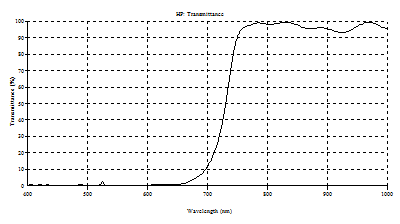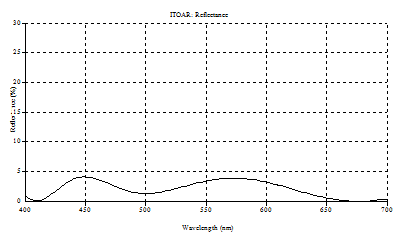
|
· Thin Film Engineering · Vacuum Deposition Equipment · Highest Quality Optical Filters & Coatings · Optoelectronic Device Design |
|
Yorkshire Photonic Technology |
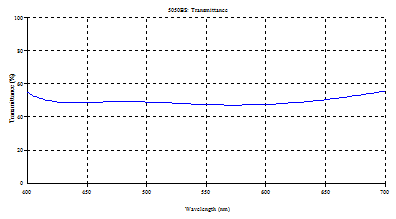
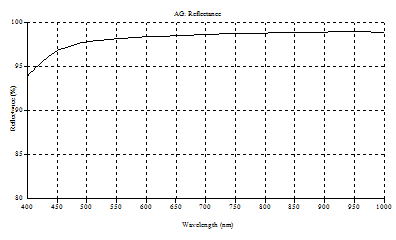
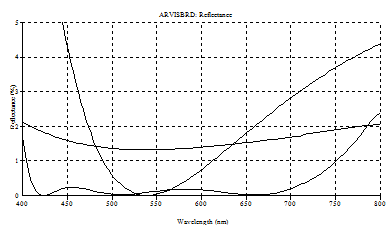







|
Equipment and capabilities include: · Dual electron gun equipped Leybold LAB600 complete with Kaufmann ion source for IAD · Single electron gun equipped Balzers BA710 with close to 400 degree deposition temperatures possible · Spectrophotometry from 170nm to 15 microns, with integrating sphere for scatter measure · McLeod, Filmstar and other software packages for interference filter and coating design · Thermal and humidity cycling test oven for testing components between 10-95% RH and 20-120°C
|
|
Coating Services |
|
Single layer magnesium fluoride antireflection coatings give around 1.5% reflectance over a reasonably broad spectral range, when deposited on 1.52 index glass. When deposited on higher indices, a magnesium fluoride single layer AR can give less than 0.5% reflectance. These coatings are relatively insensitive to incidence angle and meet US MIL 675C when deposited at elevated temperatures. Less than 0.01% reflectance can be obtained at a single wavelength for 'V' AR coatings. These coatings are usually used for specific laser wavelengths and can be designed for a range of incidence angles. Broadband multilayer antireflection coatings give less than 0.5% average reflectance over a 250nm spectral range. Our engineers have the capability to design multilayer AR coatings for a range of substrate indices, wavelengths and incidence angles, including for the mid and far IR. |
|
Antireflection Coatings |
|
Mirror coatings are based around metal or dielectric thin films. Metal mirrors are the most common and inexpensive option. They offer broad reflectance spectrums, but are soft, of poor durability and suffer from significant absorption loss. Aluminium is very versatile and durability problems can be alleviated by the use of protective overcoats of silicon monoxide or magnesium fluoride. Absorption can be reduced and reflectivity increased by enhancing dielectric multilayers deposited on top of the metal. YPT can offer both front surface and rear surface metal mirrors. Where the absorption loss is unacceptable, for example in multi-pass systems, YPT can offer all-dielectric designs. These are based on high/low index dielectric films with quarter wave thicknesses. These coatings are durable, with reflectances beyond 99% and have negligible absorption, however they have limited bandwidths. |
|
Mirrors |
|
Beamsplitters reflect a portion of the incident light and transmit the remainder. Most often they are used at a 45° angle of incidence, but YPT has the capability to design beamsplitters for other angles of incidence. For simple angular insensitive requirements, metal coatings can be used as long as a relatively large amount of absorption can be accepted. All dielectric designs can give spectrally flat transmittance and reflectance curves over about a 300nm bandwidth. Yorkshire Photonics can also offer polarising beamsplitters and beamsplitters designed specifically for cubes. |
|
Beamsplitters |
|
Using a similar design to the all dielectric high reflectors, it is possible to achieve long wave or short wave pass filters for various angles of incidence. These filters are used to reflect a portion of the incident spectrum and transmit another portion. They can be used to reflect the infrared and transmit the visible (commonly called 'hot mirrors') or transmit the infrared and reflect the visible (commonly called 'cold mirrors'). They also find application as colour filters and ultraviolet light filters. YPT also has the capability to design and manufacture bandpass and notch filters. |
|
Edge and Bandpass Filters |
|
Nichrome is most often used as a coating material for neutral density filters, while chromium's main application is for graticules and lighting gobos. YPT has the capability to deposit pinhole free chromium and nichrome at optical densities up to five, with excellent adhesion and chemical etching characteristics. For electrical contacts to semiconductor thin films, YPT can also offer gold, silver, molybdenum and other metals. |
|
Chromium, Nichrome, Gold, Molybdenum... |
|
· Thin Film Engineering · Vacuum Deposition Equipment · Highest Quality Optical Filters & Coatings · Optoelectronic Device Design |
|
· Thin Film Engineering · Vacuum Deposition Equipment · Highest Quality Optical Filters & Coatings · Optoelectronic Device Design |
|
Yorkshire Photonic Technology |
|
ITO is a solid solution wide bandgap semiconductor used in transparent conducting applications. Usually it comprises around 90% In2O3 and 10% SnO2 but by varying composition and deposition conditions, electrical and optical properties can be tailored. With additional overcoat layer, reflectance can be minimised. YPT can deposit ITO with sheet resistances from 5 to 200 ohms per square for transparent electrodes, window heating elements and RF shielding on non-conductive substrates. |
|
Indium Tin Oxide |

